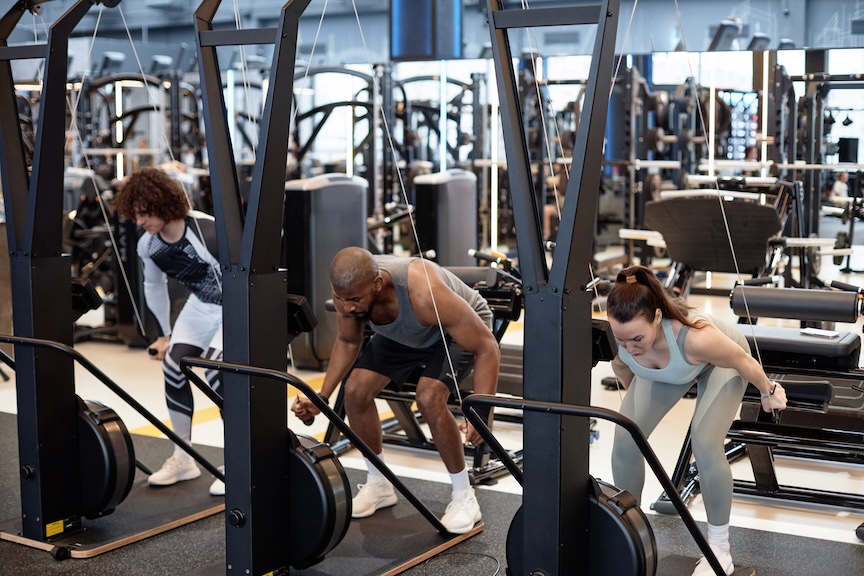From Muscle Beach to Modern Gyms: The Evolution of Fitness Centers in California
California has long been synonymous with fitness culture, but the journey from the sun-soaked sands of Muscle Beach to today’s sleek, high-tech gyms is a fascinating story of evolution. Over the past century, the fitness landscape in California has morphed from outdoor bodybuilding spectacles to sprawling wellness centers catering to all fitness needs. Let’s dive into this journey and explore how the fitness centers we know today came to be.
The Birth of Muscle Beach: California’s Fitness Icon
It all began in the 1930s at Santa Monica’s Muscle Beach, where fitness enthusiasts gathered to work out in the open air. This wasn’t just any ordinary workout space. Muscle Beach became a cultural hub, a place where beachgoers could witness some of the strongest, most physically impressive people showing off their strength, flexibility, and athleticism. It wasn’t just about lifting weights; gymnastics, acrobatics, and strength competitions turned the beach into a daily spectacle.
The atmosphere at Muscle Beach was electrifying, not just for the athletes but for onlookers, who saw fitness as an exciting form of entertainment. This was the golden age of physical culture, and it drew in big names like Jack LaLanne, who would later be known as the “Godfather of Fitness.” LaLanne opened one of the first modern health clubs in California, helping to shape the direction of fitness for years to come.
The Rise of Bodybuilding: The 1960s and 1970s
As the 1960s and ‘70s rolled around, Muscle Beach’s influence spread, particularly through the bodybuilding scene. Venice Beach emerged as a mecca for bodybuilders, with the famous Gold’s Gym becoming the birthplace of a fitness revolution. Gold’s Gym, founded in 1965 by Joe Gold, attracted bodybuilders from around the world and soon became synonymous with the sport. Figures like Arnold Schwarzenegger and Lou Ferrigno helped bring bodybuilding into the mainstream.
This era wasn’t just about aesthetics; it was also a time when fitness became more scientific. The use of weights was no longer just about building muscle—it became a way to enhance overall physical health. Training techniques became more specialized, and the gyms started to evolve into more formal indoor spaces with sophisticated equipment.
The Fitness Craze of the 1980s
The 1980s ushered in a new wave of fitness enthusiasm in California, largely driven by cultural shifts and an explosion in fitness media. With the rise of aerobics and jazzercise, fitness became more accessible to the general public. Gyms like 24-Hour Fitness and Bally’s Total Fitness expanded their reach, offering a wider range of services beyond bodybuilding.
Group fitness classes became the rage. Jane Fonda’s workout videos and the introduction of step aerobics brought high-energy exercise into living rooms across the country. This decade also saw the rise of boutique fitness classes—yoga, Pilates, and spinning classes—which catered to specific fitness preferences.
The gym was no longer just for those chasing the ideal physique—it was for everyone. And more importantly, it was about overall health and wellness, not just physical appearance. As the gym scene diversified, it set the stage for the future of fitness, where individuality and personal wellness became central themes.
Modern Gyms: High-Tech and Holistic
Today’s gyms in California are a far cry from the sandy shores of Muscle Beach. The modern fitness center is a one-stop shop for health, wellness, and even social interaction. With technology integrated into nearly every aspect of fitness, today’s gyms offer an array of services that cater to a wide spectrum of needs.Whether it’s fitness classes in San Diego, or hydromassage options in Sacramento, there’s something for everyone.

State-of-the-art equipment, from digital weight machines to cardio stations equipped with virtual reality screens, has transformed how people train. Many gyms now offer fitness tracking apps, personal trainers, and wellness consultations, ensuring that members can tailor their fitness journey to their unique goals. And, let’s not forget the rise of connected fitness with brands like Peloton and Mirror, which blend the in-gym experience with the comfort of home workouts.
Another key feature of modern fitness centers is the holistic approach to wellness. Many gyms offer not only exercise facilities but also spa treatments, nutritional counseling, and even meditation rooms. Fitness is no longer just about sculpting the perfect physique; it’s about achieving mental and physical balance.
Specialized Fitness Studios: The Next Frontier
While big-box gyms continue to dominate, there has been a surge in specialized fitness studios that cater to niche markets. Think CrossFit boxes, spinning studios like SoulCycle, or even climbing gyms. These specialized studios offer a sense of community that many traditional gyms lack. The camaraderie that comes from shared goals in an intimate setting often leads to better results and more dedicated members.
California has also embraced the outdoor fitness movement, with many opting to work out in parks, beaches, or trails. From outdoor boot camps to group runs along the coastline, Californians love to blend fitness with nature. This focus on outdoor, functional fitness harks back to the origins of Muscle Beach while embracing the modern emphasis on versatility.
The Future of Fitness in California
As we look ahead, the future of fitness centers in California seems to be about continued innovation and personalization. Virtual training programs, AI-driven fitness plans, and smart gyms that adapt to each individual’s progress are already emerging trends. But one thing remains clear: the essence of California’s fitness culture—community, health, and personal empowerment—will always be at its core.
From the sandy beaches of Muscle Beach to today’s cutting-edge fitness centers, the evolution of gyms in California reflects a broader cultural shift towards health, wellness, and a balanced life that’s modeled in gyms across the US. Whether you're a weekend warrior or a dedicated fitness enthusiast, the Golden State has something for everyone—keeping the spirit of fitness alive and well for generations to come.
 >
>